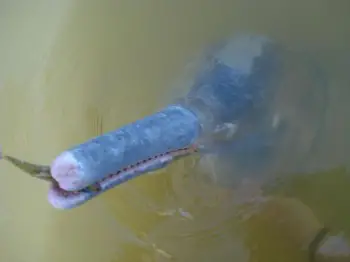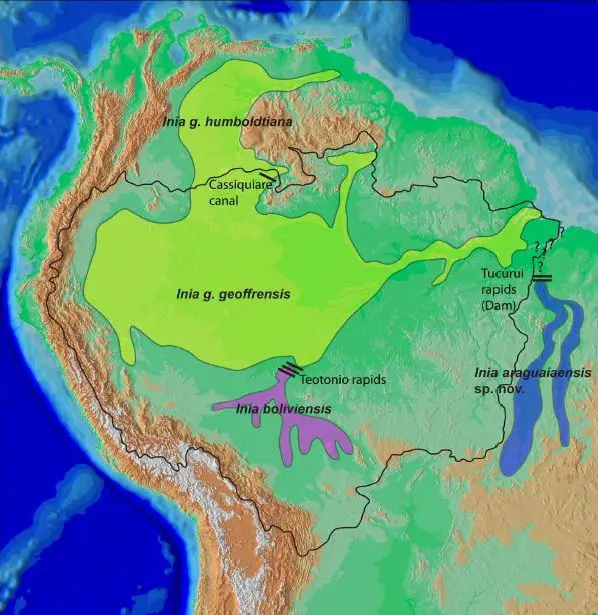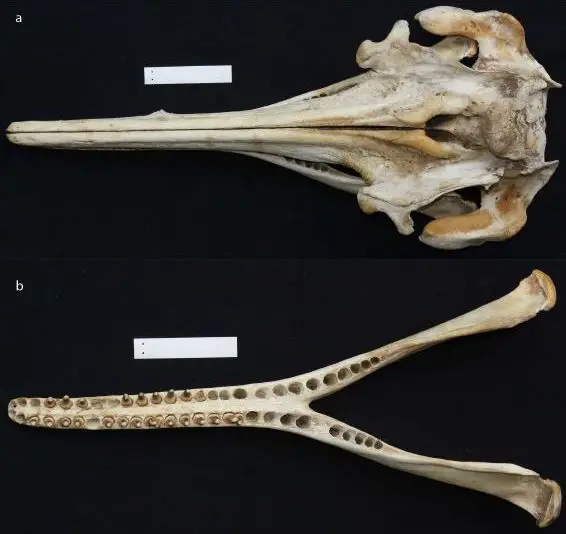River dolphin discovery raises questions about aquatic biodiversity
A new freshwater dolphin from Brazil has been described in the journal PloS ONE, and represents the first such find in almost a century.
True river dolphins, that is, those that exist solely in freshwater habitats, are exceptionally rare animals with just four extant species known prior to the new discovery.
In Asia, the two subspecies Platanista gangetica gangetica and P. g. minor inhabit the Ganges and Indus river basins in India, Bangladesh, Nepal and Pakistan, while South America is home to three species and one subspecies of the genus Inia.
All of them are considered endangered, with the Baiji, or Yangtze river dolphin, Lipotes vexillifer, having been declared extinct in 2006.
The new species has been named Inia araguaiaensis and appears endemic to the Araguaia-Tocantins river system in eastern Brazil, whereas its congeners I. geoffrensis geoffrensis, the subspecies I. g. humboldtiana, and I. bolivensis, are restricted to the Amazon, Orinoco, and Madeira basins, respectively.
The Araguaia does not currently form part of the main Amazon system, only being connected to its delta via a narrow canal west of Marajó Island (see map), and further separated by a series of major rapids on the lower Tocantins River, the largest of which have been flooded to create the Tucuruí Dam.
It is this geographic separation, thought to have occurred some two million years ago, that appears to have driven speciation in the South American river dolphins. I. bolivianus is separated from I. geoffrensis by rapids on the upper Madeira river, and contact between the two I. geoffrensis subspecies is limited by similar whitewaters on the upper Negro and Orinoco rivers, plus the Casiquiare Canal.
The three species are very similar in a morphological sense, differing only in the number of hemimandibular teeth and certain aspects of skull osteology although they are genetically and biologically distinct and display strong evidence of reproductive isolation.
Much of the scientific community consider I. bolivanus to be a subspecies of I. geoffrensis but it has been referred to as a distinct species by the Committee on Taxonomy of the Society for Marine Mammalogy since 2012, and that view is supported in this new study although the authors appear to accept that this may be challenged.
Although clearly not a fish, we’ve chosen to cover this discovery since it highlights the shortcomings and deficit of knowledge regarding Neotropical biodiversity and that work on fishes from the Araguaia-Tocantins system may reveal the need for taxonomic and conservation reanalysis of other taxa shared between the Araguaia and Amazon.
For further information download the full paper: Hrbek, T., V. M. Ferreira da Silva, N. Dutra, W. Gravena, A. R. Martin, and I. Pires Farias. 2014. A New Species of River Dolphin from Brazil or: How Little Do We Know Our Biodiversity. PLoS ONE: e83623.
Category: Discoveries, News | Tags: Amazon, Araguaia, araguaiaensis, cetacean, dolphin, Hrbek, Inia, PLoS ONE, Tocantins | 2 comments »




October 18th, 2015 at 8:05 pm
I have read about these amazing animals. Not only is there habitat being changed through pollution, dam building, restructuring of waterways, and farming but also they are also being fished for food.
I feel a breeding program should be put in place for these dolphin and other highly endangered aquatic animals whether salt or fresh water. Steps also need to be taken to ensure they have enough habitat and food to flourish. I say this because in the majority of cases such as the river dolphin their demise has been brought on through human means. Without human intervention then these and other aquatic life will surely diminish and then totally die out. Anyone who knows about the ecosystem and environment would say truthfully that our water be it rivers, oceans, seas, lakes, and yes, even streams are the basis for all life on earth. It is as Dr. Sylvia Earle has said; “Without the blue there is no green. Without the green there is no us”. Water that covers our earth form rain clouds which refreshes and oxygenates our air and drenches the land. It is obvious that that the creatures and plant life that live in these waters keep the waters from being dead.
April 27th, 2017 at 4:48 am
Just amazing, River Dolphin discovery! Prey they are saved. updates?